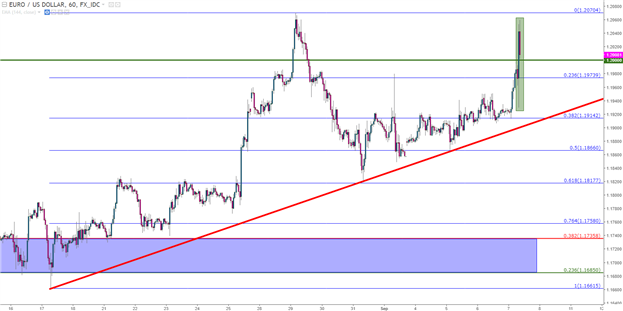At this morning’s European Central Bank rate decision, market participants walked-in with the legitimate prospect of hearing how the ECB may look to taper their asset purchase program ahead of the designated end date of December 2017. Throughout this year, European economic data has remained strong, further highlighting signs of recovery in the Euro-Zone and this has led to many calls, from both within the bloc and outside for the ECB to begin stepping away from their massive stimulus program. In response, the European Central Bank raised their growth forecasts for the economy this year, now expecting 2.2% GDP growth in 2017 versus an earlier projection of 1.9%. This would be the fastest growth rate in the Euro-Zone since 2007, and normally this would be purely a bullish factor. But normal isn’t really normal when referring to monetary policy at the present moment in time as Quantitative Tightening comes closer to reality.
Also within this morning’s updated projections was a cut to inflation forecasts. The ECB is now looking for inflation of 1.5% for this year and 1.2% for 2018. Previously the ECB was looking for 1.5% for 2017 and 1.3% for the year after, so this is effectively cutting inflation forecasts while simultaneously boosting growth expectations. The difference between the two is the Euro spot rate, which remains well-above the ECB’s expectations and can act as a further hindrance to inflationary growth, and this is likely why the ECB continues to expect inflation to remain subdued below their 2% target.
Nonetheless, the Euro rallied throughout this morning’s rate decision and press conference, further reiterating the theme of market participants trying to front-run a stimulus exit that the ECB seems want to avoid.
EUR/USD Hourly: Bullish Response to Dovish ECB Outlay, 1.2000 Break

Chart prepared by James Stanley
This has been somewhat of a brewing theme throughout this year. When ECB President Mario Draghi was asked whether the bank had discussed stimulus exit at the rate decision in April, his denial helped to bring the Euro down to support, and this lasted for about two weeks until bulls came-in to push the currency higher. A very similar reaction was seen in June, when Mr. Draghi denied that the bank had discussed exiting from their stimulus program, EUR/USD moved down to support, stayed for a couple of weeks before bulls were able to lift the currency higher-again. But in July, this began to change: When asked point-blank whether the ECB had discussed stimulus exit, Mr. Draghi again denied; but this time Euro buyers were undeterred and continued to bid the single currency higher.













Leave A Comment